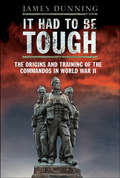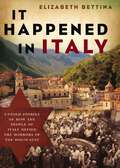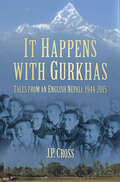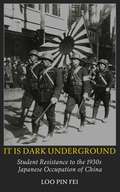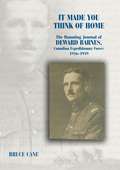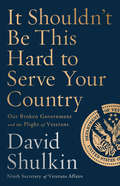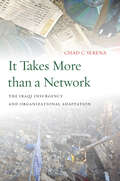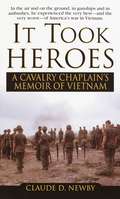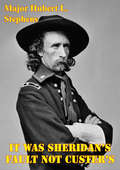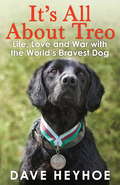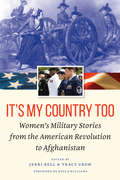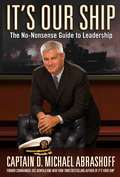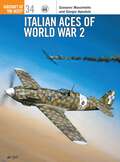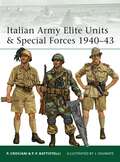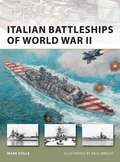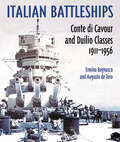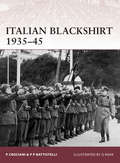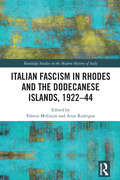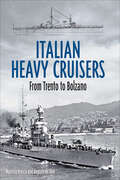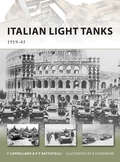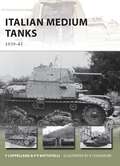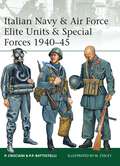- Table View
- List View
It Had to be Tough: British Commandos In The Second World War
by James DunningThis book tells the fascinating story of the origins of the Commandos (Britain's first Special Service troops and the forerunners of today's Parachute Regiment, the SAS and the SBS) and the development of their special training in World War II. The commandos were raised on the specific and personal orders of the prime minister, Winston Churchill, in the dark days of the summer of 1940 when these islands faced the real threat of a Nazi invasion. It was a bold, but typically Churchillian, decision.The book traces the formation of the Commandos and the development of the extreme and often unorthodox training methods and techniques used to prepare the volunteers from all branches of the British Army for subsequent world-wide-operations from 'bolt and butcher' raids to the 'great raids' on Norway and France and finally their employment in the full scale invasions of North Africa. Sicily, Italy, Normandy, the Crossing of the Rhine and finally in Burma, whilst at all times fostering that indomitable fighting spirit with which the name 'Commando' became synonymous. So great was the Commandos' contribution in that war that the Army Commandos were awarded thirty eight Battle Honors and these are emblazoned on the Commando Flag which hangs in Westminster Abbey. Arguably the Army Commandos were disbanded too hastily after the War but their legacy, traditions and fighting spirit lives with those artillery, engineer and corps troops who today win their coveted 'Green Berets' and serve alongside their comrades of the Royal Marines on active service today.
It Happened in Italy: Untold Stories of How the People of Italy Defied the Horrors of the Holocaust
by Elizabeth BettinaIMAGINE ELIZABETH BETTINA&’S SURPRISE when she discovered that her grandmother&’s village had a secret: over a half century ago, many of Campagna&’s residents defied the Nazis and risked their lives to shelter and save hundreds of Jews during the Holocaust. What followed her discovery became an adventure as she uncovered fascinating untold stories of Jews in Italy during World War II and the many Italians who risked everything to save them. &“Finally, somebody made known the courage and the empathy of the majority of the Italian people toward us Jews at a time of great danger.&” —Nino Asocoli
It Happens with Gurkhas: Tales from an English Nepali, 1944-2015
by J P CrossGurkhas have served with the British for almost 200 years, first with the army of the East India Company, then with the Indian Army of the Raj, and then in 1947 becoming an integral part of the British Army. This anthology of articles from The Kukri, the Gurkha regimental journals, by J.P. Cross covers much of the past sixty years of their history, taking in the last days of the Second World War and the Indonesian Confrontation in the 1960s, and also gives an insight into the everyday life, culture and beliefs of these renowned soldiers.As a Gurkha officer, J.P. Cross had many unusual experiences in his long career: in 1945, for example, he was attached to a Japanese battalion in Indochina that was fighting for the British against the Viet Minh, and the only photograph taken of this Japanese unit finally laying down its weapons appears in this book. Later, he just managed to resolve a potentially deadly dispute between an offended Gurkha and a visiting South Vietnamese trainee at the Jungle Warfare School. He also describes several seemingly supernatural experiences whilst serving with troops from a culture where such things are firmly believed in.This is a unique anthology of articles drawn from an equally unique military career and a relationship with the Gurkhas that has lasted for over half a century.
It Is Dark Underground
by Pin-Fei LooIt is Dark Underground, first published in 1946, is the first hand account of student Loo Pin Fei in the Chibna of the 1930. The books details the efforts the students made to resist the Japanese occupation of their country, including non-violent means such as distributing leaflets as well as violent means such as bombings of theaters, setting fire to supply warehouses, and carrying out assassinations of pro-Japanese Chinese. The students also worked diligently to change public opinion toward the Japanese. Their efforts were set in a time of dramatic and sweeping change in China as the Nationalist and Communist movements grew and World War Two loomed on the horizon.
It Made You Think of Home: 1916-1919
by Bruce Cane"We took our positions, five kneeling and five standing … we got the order to fire. One blank and nine live rounds … I did not have the blank." That is the voice of Deward Barnes, an unwilling but dutiful member of the firing squad that shot Harold Lodge, one of 25 Canadians executed during the First World War. In this diary we hear something that is otherwise gone forever: the authentic voice of the First World War soldier, Everyman in khaki. Fully annontated so that everyone today can understand the nuance of each entry, the Barnes diary takes us into the trenches and the firing lines of the Western Front like no other first-hand Canadian account of that terrible war can. Like any trained infantryman, Deward could tell the kick of a live round from a blank one, and that kick he bestows on us with each turn of the page.
It Shouldn't Be This Hard to Serve Your Country: Our Broken Government and the Plight of Veterans
by David ShulkinThe former VA secretary describes his fight to save veteran health care from partisan politics and how his efforts were ultimately derailed by a small group of unelected officials appointed by the Trump White House.Known in health care circles for his ability to turn around ailing hospitals, Dr. David Shulkin was originally brought into government by President Obama to save the beleaguered Department of Veterans Affairs. When President Trump appointed him as secretary of the VA, Shulkin was as shocked as anyone.Yet this surprise was trivial compared to what Shulkin encountered as secretary: a team of political appointees devoted to stopping anyone -- including the secretary himself -- who stood in the way of privatizing the agency and implementing their political agenda. In this uninhibited memoir, Shulkin opens up about why the government has long struggled to provide good medical care to military veterans and the plan he had to solve these problems. This is a book about the commitment we make to the men and women who risk their lives fighting for our country, how the VA was finally beginning to live up to it, and why the new administration may now be taking us in the wrong direction.
It Takes More than a Network: The Iraqi Insurgency and Organizational Adaptation
by Chad C. SerenaIt Takes More than a Network presents a structured investigation of the Iraqi insurgency's capacity for and conduct of organizational adaptation. In particular, it answers the question of why the Iraqi insurgency was seemingly so successful between 2003 and late 2006 and yet nearly totally collapsed by 2008. The book's main argument is that the Iraqi insurgency failed to achieve longer-term organizational goals because many of its organizational strengths were also its organizational weaknesses: these characteristics abetted and then corrupted the Iraqi insurgency's ability to adapt. The book further compares the organizational adaptation of the Iraqi insurgency with the organizational adaptation of the Afghan insurgency. This is done to refine the findings of the Iraq case and to present a more robust analysis of the adaptive cycles of two large and diverse covert networked insurgencies. The book finds that the Afghan insurgency, although still ongoing, has adapted more successfully than the Iraqi insurgency because it has been better able to leverage the strengths and counter the weaknesses of its chosen organizational form.
It Took Heroes: A Cavalry Chaplain's Memoir of Vietnam
by Claude D. NewbyThe soldiers in 1st Cav fought some of Vietnam’s fiercest battles— and Chaplain Newby was there right beside them. For grunts in Vietnam, the war was a jungle hell of sudden death, endless suffering, and supreme courage. For Chaplain Newby, it was an honor to be chosen to share it with them. In enemy-held highlands and fetid jungles, Newby regularly accompanied patrols, company-sized missions, chopper strikes, and air rescues—sharing the men’s dreams, their fears, and their dying moments. Searing, brutally accurate, and dedicated to the truth, Claude Newby’s account of brave men fighting a tragic war captures that time in all its horror and heroism. Newby doesn’t shrink from exposing the war’s darker side; his quiet description of the murderous events that came to be known as “the Mao incident” proves that justice can prevail. Ultimately, Newby’s riveting stories reveal the tremendous valor and sacrifices of ordinary Americans facing constant danger, shattering losses, and an increasingly indifferent nation. His book is a shining tribute to those who fought, those who died, and those who came home to a country determined to forget them. From the Paperback edition.
It Was Sheridan's Fault Not Custer's: And The Ties To Current Planning
by Major Hubert L. StephensMartin van Creveld, a noted theorist, contends that the concept of operational art did not take off in the U.S. until after the Vietnam War. Conversely, James Schneider, a prominent military theorist, asserts that operational art began in the American Civil War. This monograph provides a holistic analysis of four Plains Indian War Campaigns. Lieutenant General (LTG) Philip Sheridan conducted all four campaigns. This analysis illustrates several enduring principles of both operational art and counterinsurgency (COIN) operations. The purpose of the monograph is to explain the initial failure of LTG Sheridan's 1876 Centennial Campaign against the Sioux and Cheyenne Indians. Additionally, this explanation relates the significance of LTG Sheridan's planning to contemporary COIN campaign planning. The overall methodology is the incorporation of four case studies to test the theory of sanctuary control and elimination of resources to defeat insurgencies.The monograph contains three key findings. The first key finding is that the failure at the Little Big Horn was LTG Sheridan's fault not LTC Custer's, and this directly relates to the second finding. The second key finding is the importance of operational art in designing a campaign plan to link tactical actions to strategic objectives. The third finding is the efficacy of some of the current COIN tenets...Ultimately, this monograph demonstrates the utility of a strategy of exhaustion and its resulting operations to control terrain and insurgent sanctuaries as well as to deny the enemy resources to defeat an insurgency.
It's All About Treo: Life and War with the World's Bravest Dog
by Damien Lewis Dave HeyhoeThis is the incredible true story of the unbreakable bond forged between Treo, the world's most highly decorated dog, and his handler Sgt. Dave HeyhoeWhen Dave Heyhoe was sent to Afghanistan to help detect the Taliban's murderous roadside bombs, he knew he'd need a special dog by his side. Luckily for him, his closest pal Treo, a staggeringly brave ball of energy and mischief was with him every step of the way. The two friends had a miraculous understanding that helped them save countless lives but, as they embarked on a roller-coaster emotional ride, Dave realized he needed Treo more than he could ever have imagined. Tear-jerkingly sad one moment, laugh-out-loud hilarious the next, It's All About Treo is a moving and uplifting story that will melt the hearts of animal lovers everywhere.
It's All About Treo: Life and War with the World's Bravest Dog
by Damien Lewis Dave HeyhoeWhen Dave Heyhoe was sent to Afghanistan to help detect the Taliban's murderous roadside bombs, he knew he'd need a special dog by his side. Luckily for him, his closest pal Treo, a staggeringly brave ball of energy and mischief was with him every step of the way. The two friends had a miraculous understanding that helped them save countless lives but, as they embarked on a roller-coaster emotional ride, Dave realized he needed Treo more than he could ever have imagined. Tear-jerkingly sad one moment, laugh-out-loud hilarious the next, It's All About Treo is a moving and uplifting story that will melt the hearts of animal lovers everywhere. (P)2013 Quercus Publishing Plc / WF Howes
It's Like That
by Kristin LeighWhen an amazing man enters her life, shy, insecure Callie finds sizzling passion and unexpected love. But falling in love with a man whose life is filled with danger can lead to tragedy. Is heartbreak lurking in the shadows? It's Like That, Book 1 of the Wounded Warrior series, is the hot, new romance from author Kristin Leigh and will be a welcome addition to your romance library.Callie Alexson has hidden from men her entire life. Shy and self-conscious, she would rather watch from the sidelines than risk being hurt or rejected. When she's obligated to attend a friend's pool party, Callie finds herself compelled to shed her shyness beneath the penetrating scrutiny of a stranger.Chris Paulson is a force to be reckoned with and has dedicated his life to his career as a Navy SEAL team leader. He doesn't have the time or patience to deal with a love life. That is, until he finds a goddess reclining next to a SEAL team member's pool. In a single day, she will change everything. The focus he's always centered on his job shifts to the blue-eyed brunette who makes his heart beat faster.When Callie and Chris come together everything seems to fall into place. An explosive passion ignites, unlike anything either of them has ever known. They find in each other a love they never could have hoped for--and certainly were not looking for. But when Chris disappears while on a mission, Callie is left behind to face the heartbreak. Will he return to her a broken man? And if he does, can Callie be what he needs to banish the dark demons that haunt his soul?Content Notes: Hot
It's My Country Too: Women's Military Stories from the American Revolution to Afghanistan
by Kayla Williams Tracy Crow Jerri BellThis inspiring anthology is the first to convey the rich experiences and contributions of women in the American military in their own words—from the Revolutionary War to the present wars in the Middle East. Serving with the Union Army during the Civil War as a nurse, scout, spy, and soldier, Harriet Tubman tells what it was like to be the first American woman to lead a raid against an enemy, freeing some 750 slaves. Busting gender stereotypes, Josette Dermody Wingo enlisted as a gunner’s mate in the navy in World War II to teach sailors to fire Oerlikon anti-aircraft guns. Marine Barbara Dulinsky recalls serving under fire in Saigon during the Tet Offensive of 1968, and Brooke King describes the aftermath of her experiences outside the wire with the army in Operation Iraqi Freedom. In excerpts from their diaries, letters, oral histories, and pension depositions—as well as from published and unpublished memoirs—generations of women reveal why and how they chose to serve their country, often breaking with social norms, even at great personal peril.
It's Our Ship: The No-Nonsense Guide to Leadership
by Captain D. AbrashoffCaptain D. Michael Abrashoff, legendary commander of the USS Benfold, continues in the same vein of his bestselling book IT'S YOUR SHIP with the knowledge he's gained from his speaking to and advising some of the top business minds in the world. The story of Captain Abrashoff and his command of USS Benfold has become legendary inside and outside the Navy. By governing his ship with his unique management techniques, Abrashoff turned the Benfold into a model of naval efficiency, with amazing cost savings, the highest gunnery score in the Pacific Fleet, and a highly motivated and top performing crew. In IT'S YOUR SHIP, he first demonstrated how to bring his successful management techniques from the ship to the boardroom. Now, in his newest book IT'S OUR SHIP, in the same rugged, can-do voice, Abrashoff will focus on the leadership, motivational, and management insights and tips that he has learned from his last six years of addressing business and corporate audiences. Abrashoff's timely advice will be eminently prescriptive, and will feature anecdotes and insights from leaders of businesses large and small and from public and non-profit sectors.
Italian Aces of World War 2
by Richard Caruana Giorgio ApostoloFlying aircraft such as the Macchi 200-202, Fiat G.50 and biplane Fiat CR.42, the Italian fighter pilots were recognised by their Allied counterparts as brave opponents blessed with sound flying abilities, but employing under-gunned and underpowered equipment. Following the Italian surrender in September 1943, a number of aces continued to take the fight to the Allies as part of the Luftwaffe-run ANR, which was equipped with far more potent equipment such as the Bf 109G, Macchi 205V and Fiat G.55. Flying these types, the handful of ANR squadrons continued to oppose Allied bombing raids on northern Italy until VE-Day.
Italian Army Elite Units & Special Forces 1940-43
by Pier Battistelli Johnny ShumateItalian military historian Pier Paolo Battistelli examines the elite and specialforces units of the Italian Army during World War II. This includes a vast array of troop types, including paratroopers, assault engineers, sea-landing and swimmer units, long-range recce and ski units, and even hand-picked Fascist 'Mussolini' units. It also delves into the specialist tank and armoured units that were created to emulate the German armoured units. While the Italian units discussed enjoyed mixed success, the volume draws attention to the incredibly hard fighting done by some in the deserts of North Africa and the frozen wastelands of Russia. Illustrated with rare archival photographs and specially commissioned artwork, this is a fascinating insight into a little-studied aspect of Axis forces.
Italian Battleships of World War II
by Paul Wright Mark StilleOften overlooked as a naval power of WWII, Italy's Regia Marina was, upon the declaration of war against France, the fourth largest navy in the world. Despite its numbers, the Italian fleet was made up of largely obsolete vessels, none being equipped with radar, and had a reputation for having inadequately-trained crews. Added to these drawbacks, the Italian commanders did not enjoy the discretion of command at sea that their counterparts in the service of other nations did, being directed closely by the Supermarina (Italian Naval Headquarters). Despite these obstacles, and the heavy losses inflicted upon the fleet by the Royal Navy while in harbour at Taranto, the battleships of the Italian Navy enjoyed a good reputation for being well-designed, and served with courage and determination at Punto Stilo/Calabria, Sirte, Cape Spartivento, and Cape Matapan. Mark Stille details, with the aid of many stunning photographs, including several from the Italian Navy's own archives, the battleships of one of the forgotten navies of WWII.From the Trade Paperback edition.
Italian Battleships: Conte di Cavour and Duilio Classes 1911–1956
by Erminio Bagnasco Augusto de ToroWith the publication of their previous book on the battleships of the Littorio class, the authors set new standards for the detailed coverage and sophisticated analysis of Italian warship design. Inspired by its success, both critically and commercially, the authors were inspired to follow up with a similar study of the earlier Italian battleships that were built in the First World War but survived to fight in the Second. Given the level of new research required, this has taken a decade to achieve but the result is a similarly comprehensive coverage. Originally comprising five ships in two related classes, they entered service at the beginning of the Great War. As designed, they were powerful examples of the second generation of dreadnoughts, with a combination of twin and triple turrets producing a unique main armament of thirteen 12-inch guns. One ship, Leonardo da Vinci, was sunk by an internal explosion at Taranto in 1916, and although the hull was raised post-war, the plan to rebuild the ship was abandoned as it was not deemed cost-effective. However, the remaining four ships were to undergo one of the most radical reconstructions of any battleship class during the 1930s, emerging with an entirely new profile, more powerful machinery and all the characteristics of a modern fast battleship. In this form they became an important element in the Italian fleet that opposed the British after 1940\. This book covers all the technical details of the ships, both as built and as rebuilt, but also provides an extended history of their active service, including battle plans and track charts. Thoroughly illustrated with photographs, ship and armament plans, detail drawings and colour camouflage schemes, the book is a fitting companion to The Littorio Class.
Italian Blackshirt 1935-45
by Pier Battistelli Giuseppe RavaThe Blackshirt legions were raised under army control from 1928, and were employed in 1933 in Libya in counterinsurgency operations against the Senussi tribes; from 1935 in Italy's war against Ethiopia; and during the Spanish Civil War. Following the outbreak of World War II, the Blackshirts fought in North Africa, Greece, Croatia, on the Eastern Front and finally in Italy itself following the Allied invasion.This book documents the experiences of the Italian armed Fascist militia, the Camicie Nere (Blackshirts), from the Italian-Ethiopian war (1935-1936), through the Spanish Civil War (1936-1939) to the end of World War II (1939-1945). It explores their origins, development, recruitment, training, conditions of service, uniforms and equipment, battle experience, political and ideological motivation.
Italian Fascism in Rhodes and the Dodecanese Islands, 1922–44 (Routledge Studies in the Modern History of Italy)
by Aron Rodrigue Valerie McGuireThis book is the first English-language collection of scholarly essays to investigate the ambiguous and supporting role that colonialism in the Aegean Region played in Mussolini’s imperial ambitions, bringing to light a history rarely scrutinized until recently.The Dodecanese archipelago is often absent from histories of Italian fascist colonialism, as Italian territories in East Africa, Libya, and the Balkans have figured more centrally in discussions of how nationalism and later fascism relied on the empire to promote discourses of national renewal and regeneration. Over the past twenty years, a new wave of research has emerged, animated by the opening of previously closed state archives in various countries. This volume’s international contributors provide fresh perspectives on a topic frequently mythologized as a “golden period” of social and cultural intimacy among twentieth-century Greeks, Turks, and Jews. Themes include the fascist adaptation in the islands of Ottoman imperial governance, programs of infrastructure, development, and administration in the Dodecanese, Jewish history and memory in Rhodes, and the place of the islands in larger regional tensions of the interwar period. The volume will be of interest to scholars of Italian history, modern colonialism, fascism, Mediterranean studies, the end of the Ottoman Empire, and Sephardic Jewry.
Italian Heavy Cruisers: From Trento to Bolzano
by Maurizio Brescia Augusto de ToroA technical history of seven Italian heavy cruisers: Trento, Trieste, Bolzano, Zara, Fiume, Gorizia, Pola—a perfect companion volume to Italian Battleships.When the Washington Naval Treaty of 1922 effectively banned the building of battleships, competition between the major navies concentrated on the next most powerful category, heavy cruisers limited to ten thousand tons displacement and eight-inch guns. Italy followed this trend, the first design for what became Trento and Trieste being ordered in 1924. These were the fastest of the first generation ‘Treaty’ cruisers but were very lightly armored, and the succeeding Zara class of four ships were slower but better protected. However, before the final ship of this class (Pola) had been completed, there was a return to the earlier fast, lightly protected concept with the Bolzano, although this ship also incorporated aspects of the Zara design. The political background, design history and technical features of these classes are covered in great depth in this volume. They were important ships, subject to incremental improvement so no two were identical, and model makers will appreciate the space devoted to the variations in appearance, using both description and illustration. As major units of the Italian battle fleet, they were more active than most during the war and their careers are fully detailed, including analyses of damage suffered. Tragically, they were all sunk, and the circumstance of each loss is explored. As befits a technical history, the book is thoroughly illustrated with ship and armament plans, detail drawings and color camouflage schemes, as well as an outstanding collection of photographs.
Italian Jewish Musicians and Composers under Fascism: Let Our Music Be Played (Italian and Italian American Studies)
by Alessandro Carrieri Annalisa CapristoThis book is the first collection of multi-disciplinary research on the experience of Italian-Jewish musicians and composers in Fascist Italy. Drawing together seven diverse essays from both established and emerging scholars across a range of fields, this book examines multiple aspects of this neglected period of music history, including the marginalization and expulsion of Jewish musicians and composers from Italian theatres and conservatories after the 1938–39 Race Laws, and their subsequent exile and persecution. Using a variety of critical perspectives and innovative methodological approaches, these essays reconstruct and analyze the impact that the Italian Race Laws and Fascist Italy’s musical relations with Nazi Germany had on the lives and works of Italian Jewish composers from 1933 to 1945. These original contributions on relatively unresearched aspects of historical musicology offer new insight into the relationship between the Fascist regime and music.
Italian Light Tanks
by Richard Chasemore Filippo CappellanoThe Italian army, unlike those of the British and French, did not use tanks in combat during World War I and, by November 1918, only one training unit equipped with French Schneider and Renault tanks had been formed. Consequently, during the 1920s the Italian army had just one single tank type in its armoured inventory - the Fiat 3000. Only in 1927 was the first tank unit formed as a branch of the infantry and not as an independent organization, while the cavalry rejected the idea of both tanks and armoured cars and decided to stand by the use of horses for its mounted units. Between 1933 and March 1939, a further 2,724 CV 33 / L 3 tanks were built, 1,216 of which were exported all over the world. By the time Italy entered the war in June 1940, the army had 1,284 light tanks, 855 of which were in combat units, including three armoured divisions. Variants of the CV 33 / L 3 tanks included flame-throwers, bridge-layers, recovery vehicles, and a radio command tank. Some L 3 tanks were still in use in 1945, by both the Germans and the German-allied Italian units of the Repubblica Sociale.
Italian Medium Tanks
by Pier BattistelliSeveral factors delayed and greatly hampered the development of an Italian medium and heavy tank during Rommel's Desert War in World War II. The first was the strategic stance of the country, focussed on a war against neighbouring countries such as France and Yugoslavia, and ill-prepared for a war in the Western Desert. Since these European countries bordered with Italy in mountainous areas, light tanks were preferred as these were deemed much more suitable for the narrow roads and bridges of the Alps. The failure to develop an effective operational plan for North Africa was another factor behind the failed development of an Italian medium tank, along with the lack of communication between the War Department and the Ministry of the Colonies, which not only had actual command over the Italian forces deployed in the Italian colonies of Libya and in Italian East Africa, but was also responsible for developing their defence plans. Furthermore, the development of the medium tank was hampered by the limited number of Italian industries, whose production was also heavily fragmented - hence the SPA-developed engines, the Fiat and Ansaldo hulls and armour, the Breda and army ordnance guns. All these factors delayed the development of the first prototype of an Italian medium tank - the M 11 - which would only appear in 1937 and did not enter production until 1939.Inspired by its British and French counterparts, the M 11 / 39 was a 11-ton medium tank chiefly intended for use as an infantry tank, with its main gun (a 37/40 gun) mounted in a casemate in the hull and its small turret armed only with two machine guns. Actual production was limited to only 100 samples, 76 of which were sent to Libya and the other 24 to Eastern Africa, as production of the turret-gun-armed M 13 had started in the meantime. In June 1940, when Italy entered the war, her armoured inventory numbered fewer than 1,500 light tanks (including the obsolete Fiat 3000) and the 100 newly built M 11 medium tanks, divided amongst three armoured divisions, three cavalry groups and several independent tank battalions. Unsurprisingly, without a tank school, the Italian armoured force lacked the necessary training and experience in the use of tanks and AFVs, and with the tanks lacking radio equipment, there was a widespread absence of tactical and technical knowledge which, along with the limited effectiveness and numbers of the available tanks, made the perfect recipe for the defeats to come.From the Trade Paperback edition.
Italian Navy and Air Force Elite Units and Special Forces 1940-45
by Mark Stacey Piero CrocianiThis volume assesses the formidable Special Forces fielded by Italy's navy and air force in World War II. Italian Navy Special Forces were particularly active and respected in the Mediterranean, where 10th Motor-Torpedo Boat Flotilla used frogmen, 'two-man torpedoes' and explosive ram-boats. The Italian Air Force formed a special commando unit, ADRA, before the 1943 surrender; it was tasked with attacking Allied airfields and communications in North Africa. Men from ADRA and Army paratroopers formed the new 'Folgore' Regiment, which also continued to fight alongside German forces until 1945. In both cases, the pro-Allied Italian forces also formed 'mirror' units to fight alongside US and British forces, including the Recce Squadron 'F'. Featuring rare photographs and specially commissioned artwork, this book tells the story of the little-known elite forces fielded by Italy's navy and air force in World War II, some of whose successors remain in service with today's Italian armed forces.
